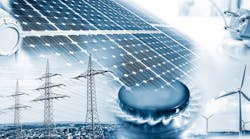This October, I had the honor and privilege to speak at the 13th Annual Electric Power Industry Conference (EPIC) in Pittsburgh and covered an overview of some of the key challenges and opportunities facing our industry today. The list topics ranged from defecting customers, including those anticipating or doing their own production with microgrids and distributed energy resources (DER) to aging workforce.
DER is setting an explosive pace as a significant source of our grid. According to the Energy Information Agency (EIA) nearly 17% of generation comes from renewable resources. According to the Solar Electric Industry Association (SEIA), 29% of all new electric generation capacity brought on line in the first half of 2018 came from solar PV. Although residential PV growth has “stabilized” and has had a flat growth, community solar is gaining momentum, due in part by initiatives led by Minnesota and Massachusetts. Utility PV is still the largest segment with nearly 1.2 GW (dc) coming on line in 2Q 2018 and accounts for 55% of the installed solar capacity installed.
In the case of the workforce issue, it is estimated that 25% of the current energy industry workforce will retire in five years. This last statistic is further compounded as highlighted in the Jan 2017 survey of the US Energy and Employment Report that points out that the most significant reasons for hiring difficulty in the utility industry is “Insufficient qualifications, certification and education” (61% of respondents)
The American Society of Civil Engineers (ASCE) has given our energy infrastructure a D+ Grade in their 2017 Infrastructure Report Card, citing the fact that “Much of the U.S. Energy system predates the turn of the 21 century. Most of the electric transmission and distribution lines were constructed in the 1950’s and 1960’s with a 50-year life expectancy.”
With these two topics as a two bookends, it is clear that our key resources, both in terms of technology and skills capability are in the state of significant transformation.
One could postulate that the increasing use of DER can very likely help alleviate some of the infrastructure challenges, since it holds the potential of bringing generation closer to the load. However, the complexity of managing this new distributed and highly flexible (and somewhat unpredictable) grid very likely will exacerbate the challenges of dealing with the looming loss of deep expertise that is resident in our current workforce, many of whom may soon be thinking about retirement.
The efforts underway at the University of Pittsburgh’s Swanson School of Engineering and their GRID Institute - located at the Pittsburgh Energy Innovation Center - may be well poised toward helping our industry avoid the crisis that these two situations (DER and Aging workforce) and are taking the necessary steps of closing gap between industry and education.
While there is no shortage of testing laboratories around the globe, a vast majority of them are commercial or scientific enterprises that are focused on compliance and safety certifications, or a limited development purpose. What makes the Pitt GRID Institute unique, is that they have collaborated with Duquesne Light Co., Eaton, and other prominent industry partners to bring in a dedicated and live 15 kV, 5 MVA working distribution network into a research lab. Having this comprehensive test-bed as a foundational asset, now allows students and scientists to study, analyze and execute test scenarios on a live circuit in a fully operational environment at utility scale and application.
Our energy fate is in the hands of the future generation of innovators, problem solvers and researchers who can bring new perspectives to our issues; inquire and experiment with the right and appropriate tools and who can continue to improve upon the largest and most complex machine, the electric grid.
Kudos to Dr. Greg Reed and the many others of dedicated and passionate individuals for executing and delivering on the vision of combining utility, industry and academia to help study the challenges, solve the problems encountered and inspire emerging engineers to meet our human resource needs.
Electric Power Industry Conference is a T&D World media partner.
References
[1] https://www.eia.gov/tools/faqs/faq.php?id=427&t=3
[2] https://www.seia.org/research-resources/solar-market-insight-report-2018-q3
[3] Ibid
[4] https://www.energy.gov/policy/downloads/quadrennial-energy-review-second-installment Chapter V The Electricity Workforce of the 21st Century: Changing Needs and New Opportunities.\
[5] https://www.energy.gov/sites/prod/files/2017/01/f34/2017%20US%20Energy%20and%20Jobs%20Report_0.pdf page 35.
[6] https://www.infrastructurereportcard.org/americas-grades/
[7] https://www.infrastructurereportcard.org/wp-content/uploads/2017/01/Energy-Final.pdf


